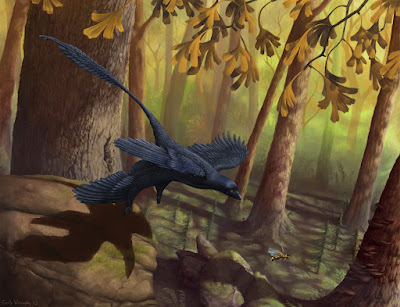I've actually had a few people recently comment on my accurate cast shadows in my artwork, so I thought I'd share a little secret.
I have some difficulty composing accurate cast shadows in my head, though I've gotten much, much better at it over the years, thanks in large part to Jon who has been tirelessly critiquing my shading since 2006. He has an almost uncanny ability to rotate three-dimensional objects in his head, an ability that I don't have to quite that degree. However, I have more recently acquired an additional skill in my toolbox for shading, something I learned from the great James Gurney.
Recently I set out to reconstruct a four-and-a-half-year-old picture of mine that had fallen far out of date both in terms of accuracy and artistic proficiency:
This picture was drawn for a publication that, then in its infancy, is now finally bordering on the cusp of maturation, but after the Microraptor color study I knew I had to redo this one to bring it up-to-date. I wanted the composition to remain nearly the same, but the animal itself needed a makeover, and this included the cast shadow.
Lo and behold - I'm actually not terrible at sculpting. Who knew?
Of course, this sculpt involved just the barest of details, and will probably never be "completed" in the sense of being a finished sculpture, but I did my best to make it anatomically accurate and it certainly served its intended purpose. The basic lateral anatomy is based on the original drawing in Xu Xing 2003:
And then beefed up with what I know of dromaeosaurid and bird anatomy with a very lightweight type of modeling clay.
Using the guideline of the model, I could then create the finished image with cast shadows intact.
Obviously this sort of process is far too time-consuming to use on everything I draw, but it's kind of fun for more important paintings that need to be as accurate and consistent as possible.





Very impressive.
ReplyDeleteThe sculpt is impressive too, Emily. What substrate did you use under the soft clay?
ReplyDeleteWhy don't you try completing it (or making a complete one), just for the hell of it? it would be like painting in 3D, like climbing into the picture. Gieger tried it, and liked it so much that now he doesn't do images anymore, only sculpting.
I'd even suggest doing a large one first, so you have finer control of the details.
Your pal,
- faye
PS:
Your dromaeosaur is my fave shirt! Someone asked me about it and I proudly told them "...and I know the girl who drew that!"
PPS:
When an artist sculpts from clay, how do they harden it so it doesn't deform during when packed in a box and kids don't pull chunks off? Do you have to find a kiln somewhere, or is there hardening spray, or what?
Thanks so much! The soft clay is built around paper (for the shape of the limbs), wire (skeleton), and balled up aluminum foil for the body cavity - nothing too fancy.
DeleteI might try completing it just for the hell of it at some point, it's just a matter of having the time for it. But I think I would enjoy sculpting if I could manage some practice.
P.S. Awww you bought a shirt? I'm so glad you like it! :D
P.P.S. I think most types of clay are the sort you bake in an oven or a kiln to harder, though there also exists air-dry clay (which is the kind I used for the Microraptor - it's very lightweight). I don't really have access to a kiln, but I'm pretty sure I could use a standard kitchen oven for it if I wanted to try that kind.
Sorry for the slow reply - Blogspot does not email me or notify me in any way I can tell when I get comments. :<
Good information.
ReplyDeleteKING99